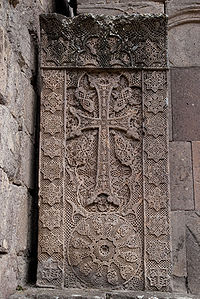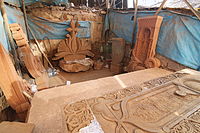- Khachkar
-
"Kachkar" redirects here. For the mountain range in Turkey, see Kaçkar Mountains.
Khachkar  The famous khachkar at Goshavank, carved in 1291 by the artist Poghos.
The famous khachkar at Goshavank, carved in 1291 by the artist Poghos. Two 16th century Julfa-type khachkars, removed from the Julfa graveyard before its destruction by Azerbaijan.
Two 16th century Julfa-type khachkars, removed from the Julfa graveyard before its destruction by Azerbaijan. A modern-day khachkar carver's workshop in downtown Yerevan.
A modern-day khachkar carver's workshop in downtown Yerevan.
A khachkar or khatchkar (Armenian: խաչքար, pronounced pronounced [χɑtʃkɑɹ], meaning cross-stone) is a carved, cross-bearing, memorial stele covered with rosettes and other botanical motifs[1]. Khachkars are characteristic of Medieval Christian Armenian art found in Armenia.[2]
Contents
Description
The most common khachkar feature is a cross surmounting a rosette or a solar disc. The remainder of the stone face is typically filled with elaborate patterns of leaves, grapes, pomegranates, or abstract knotwork. Occasionally a khachkar is surmounted by a cornice with biblical or saintly figures.
Most early khachkars were erected for the salvation of the soul of either a living or a deceased person. Otherwise they were intended to commemorate a military victory, the construction of a church, or as a form of protection from natural disasters.[3]
The most common location for early khachkars was in a graveyard. However, Armenian gravestones take many other forms, and only a minority are khachkars.
History
The first true khachkars appeared in the 9th century, during the time of Armenian revival after liberation from Arab rule. The oldest khachkar with a known date was carved in 879 (though earlier, cruder, examples exist). Erected in Garni, it is dedicated to queen Katranide, the wife of king Ashot I Bagratuni. The peak of the khachkar carving art was between the 12th and the 14th centuries. The art declined during the Mongol invasion at the end of the 14th century. It revived in the 16th and 17th centuries, but the artistic heights of the 14th century were never achieved again. Today, the tradition still remains, and one can still see khachkar carvers in some parts of Yerevan.[4]
About 40,000 khachkars survive today. Most of them are free standing, though those recording donations are usually built into monastery walls. The following three khachkars are believed to be the finest examples of the art form:
- One in Geghard, carved in 1213, probably by master Timot and master Mkhitar
- The Holy Redeemer khachkar in Haghpat (see gallery), carved in 1273 by master Vahram
- A khachkar in Goshavank, carved in 1291 by master Poghos).
A number of good examples have been transferred to the Historical Museum in Yerevan and beside the cathedral in Echmiadzin. The location in Armenia with the largest surviving collection of khachkars is the field of khachkars at Noraduz cemetery, on the western shore of the Lake Sevan, where an old graveyard with around 900 khachkars from various periods and of various styles can be seen. The largest collection in the world was formerly located in Julfa in the Nakhichevan Autonomous Republic of Azerbaijan until it was destroyed by their government.
Present
The art of carving Khachkars has witnessed a rebirth as a symbol of Armenian Culture. Beginning within the Armenian Diaspora after World War II, Khachkars have been erected in places such as Poland, where in the cities Wrocław, Kraków, and Elbląg they were put in place as memorials to commemorate the victims of the Armenian Genocide by the Polish Armenian Community. A further boost in the production of these monuments came about after Armenia resumed its independence with the Dissolution of the Soviet Union.
Endangered khachkars
A large portion of khachkars, which were created in historic Armenia and surrounding regions, in modern times have become the possession of Turkey, Azerbaijan, and partly Georgia and Iran. As a result of systematic eradication of khachkars in Turkey, today only a few examples survive. Unfortunately these few survivors are not cataloged and properly photographed. Thus, it is difficult to follow up with the current situation.[5] One documented example is the Khachkar destruction in Nakhchivan.[6][7][8]
One source says that khachkars are being damaged, neglected, or moved in Armenia.[9] Reasons cited for moving these khachkars include; decoration, to create new holy places, or to make space for new burials.
Types
Amenaprkich
Amenaprkich (Armenian: Ամէնափրկիչ, meaning Holy Saviour) is a term used to describe a particular type of khachkar, in which on the cross is a depiction of the crucified Christ. Only a few such designs are known, and most date from the late 13th century.
Gallery
-
Khachkar at Haghartsin Monastery, near Dilijan, Armenia.
-
The Holy Savior khachkar in Haghpat (1273)
-
Various khachkars at Makaravank Monastery in Armenia
-
A khackhar at the Armenian Catholicossate of Cilicia in Antelias, Lebanon
-
A khachkar in Sanahin
-
A monumental medieval khatchkar at the Armenian monastery of Sanahin in 1902
-
A large 13th century khachkar at Gandzasar Monastery in Nagorno-Karabakh
-
The famous double khachkars of the Memorial Bell-Tower of the Dadivank Monastery in Nagorno-Karabakh
-
Khachkar at Goshavank
References
Citations
- ^ Thierry, cover sleeve.Thierry 1989
- ^ Gough M., The Origins of Christian Art, London, 1973
- ^ “Armenian Khatchkars” (Editions Erebuni, 1978)
- ^ Anatoli L. Yakobson. Armenian Khachkars, Moscow, 1986
- ^ Der Nersessian S. Armenian Art, Paris, 1978.
- ^ "Azerbaijan: Famous Medieval Cemetery Vanishes". Caucasus Reporting Service, Institute for War and Peace Reporting. April 19, 2006. http://iwpr.net/?p=crs&s=f&o=261191&apc_state=henh. Retrieved 2007-04-15.
- ^ "World Watches In Silence As Azerbaijan Wipes Out Armenian Culture". The Art Newspaper. 2006-05-25. http://www.theartnewspaper.com/article01.asp?id=281. Retrieved 2006-05-25.
- ^ "Tragedy on the Araxes". Archaeology. 2006-06-30. http://www.archaeology.org/online/features/djulfa/index.html. Retrieved 2006-06-30.
- ^ Khachkar.am: Endangered Khachkars
Other sources
- ^ Thierry, Jean-Michel (1989) Armenian Art. New York: Harry N. Abrams. ISBN 0-8109-0625-2
See also
External links
- Khatchkar collection at Armenica.org
- Old Jugha page on Armeniapedia
- Destruction of Jugha khachkars by Azeri soldiers captured in photos and movie clips.
- Khachkar page on Armeniapedia (many photos)
- Photos at Armenia Photos.info
- Photos of 15th/16th CE khatchkars near Bitlis, Turkey
- Khachkar.am :: Everything about khachkars
- Triumph of Tolerance or Vandalism?
- Photos and history of Khachkars
- Djulfa Virtual Memorial and Museum
- Photos of Exceptional Samples of Armenian Cross-Stones (Khachkars)
Categories:- Monuments and memorials in Azerbaijan
- Armenian art
- Monuments and memorials in Armenia
- Stones
- Monumental crosses
- Christian symbols
- Cross symbols
Wikimedia Foundation. 2010.

















